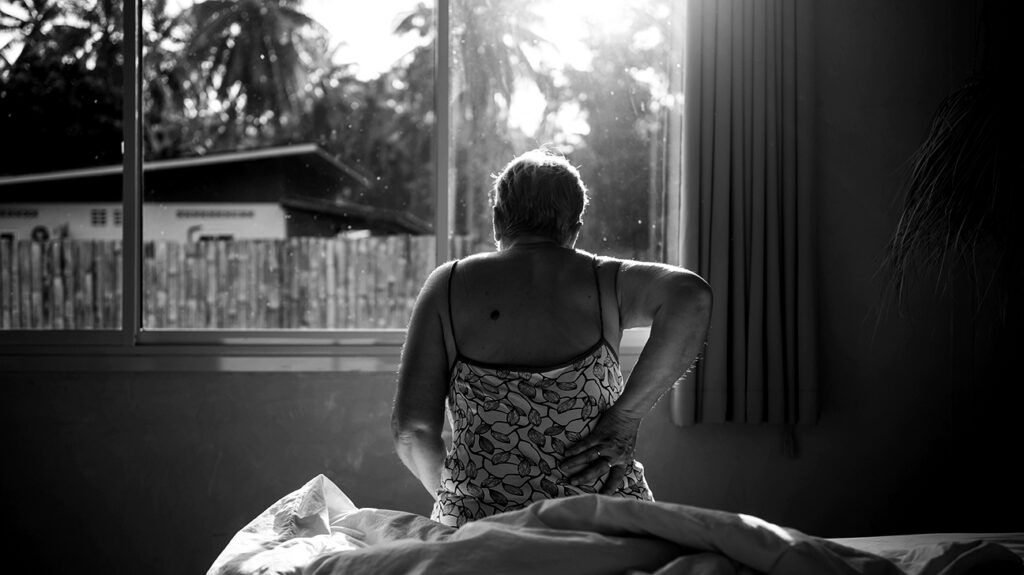Kidney cancer can cause pain in the lower back or around the flanks. The pain may be constant, and it may only occur on one side of the body.
When kidney cancer develops, it may not cause noticeable symptoms at first. However, as the condition progresses, pain often develops. Pain from kidney cancer may not occur until the mass has grown and the disease is in later stages.
It is helpful to understand where kidney cancer pain may start. This can help a person know when they need to see a doctor for an evaluation.
The article below examines the location of kidney cancer pain and what it feels like, how to manage kidney cancer pain, and more.

Kidney cancer pain
The pain may develop on one side of the body, and it may not go away.
Kidney cancer can also cause sharp pain in the abdomen and groin area.
It is also important to understand that pain in the back or sides occurs commonly and can develop for other reasons besides kidney cancer. It is best to contact a doctor for an accurate diagnosis.
Learn about the link between kidney cancer and back pain.
As with all types of cancer, pain management is unique. What helps one person may not help someone else.
Medications may include:
- nonopioids, such as acetaminophen and nonsteroidal anti-inflammatory drugs (NSAIDs)
- opioids, such as morphine, oxycodone, and fentanyl
- adjuvant analgesics, such as corticosteroids, antidepressants, and topical agents
In general, as kidney cancer treatment shrinks the tumor, pain may get lower. Treatment for kidney cancer may include:
Learn about treatments for kidney cancer.
According to the National Kidney Foundation, most people do not usually have signs and symptoms in the early stages of kidney cancer. However, over time, symptoms can develop.
In addition to back and side pain, kidney cancer can cause other symptoms, such as:
- blood in the urine
- a lump on the lower back or the side
- fatigue
- loss of appetite
- fever
- unexplained weight loss
Learn more about the symptoms of kidney cancer.
Doctors diagnose kidney cancer by:
- reviewing a person’s medical history
- asking questions about symptoms
- performing a physical exam
- ordering tests
Imaging tests provide pictures of the kidneys to determine the presence of a tumor. Some types of imaging tests may help identify whether a tumor is solid or a fluid-filled cyst.
Possible imaging tests may include:
In some cases, a doctor may recommend a kidney biopsy. This involves removing a small piece of kidney tissue with a needle to test for cancer cells.
The doctor may also order blood and urine tests to check for irregularities.
It is best to contact a doctor if a person experiences frequent or persistent pain in their back or side. Although there are many possible causes of back or side pain, it is best to receive an accurate diagnosis.
A person may also need to contact a doctor if they notice blood in their urine. Blood in the urine can also occur with other conditions, such as a urinary tract infection (UTI). However, it is important to see a doctor to determine the cause of symptoms and rule out kidney cancer.
Here are some frequently asked questions about kidney cancer.
Where does the pain start with kidney cancer?
Kidney pain
At what stage does kidney cancer cause pain?
Pain from kidney cancer usually starts in advanced stages. About
Doctors often find kidney cancer by chance during abdominal imaging.
What is the most common initial symptom of kidney cancer?
Kidney cancer symptoms may differ for each person. Symptoms may include blood in the urine, pain or a lump in the lower back or side, fatigue, and unexplained weight loss.
Do you have constant pain with kidney cancer?
The severity and consistency of kidney cancer may vary. For some people, the pain can remain constant.
Kidney cancer does not typically cause symptoms in the early stages. As the condition progresses, pain may develop. Kidney cancer pain usually occurs in the lower back and on one side of the body, between the ribs and the hips.
Additional symptoms of kidney cancer include blood in the urine, fever, and weight loss.
Management of kidney cancer pain includes medication such as opioids, nonopioids, and adjuvant analgesics. Treatments that shrink the size of the tumor may also help.
